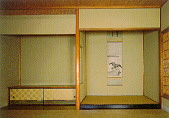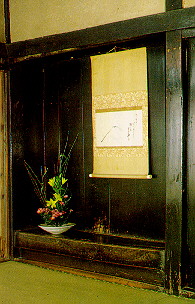

The tokonoma (or decorative alcove) is considered one of four elements found in the main hall of a samurai residence whose function is that of display. The term tokonoma has a dual meaning, since it refers both to the alcove itself, as well as a room containing a decoirative alcove. The decorative alcove has historically been called the oshiita, however it is proper to use either of the terms.
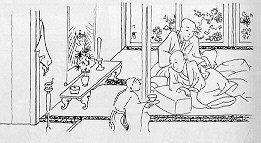 Early
forms of this element can be found in the biography of the monk Kakunyo
who lived between 1270-1351. This collection of painted scrolls is called
the Pictures Longing for Extinction (Bokie). The scrolls illustrate the
monk’s daily life within an architectural setting. The ten scrolls were
originally painted in 1351 (figure 1 and 2).
Early
forms of this element can be found in the biography of the monk Kakunyo
who lived between 1270-1351. This collection of painted scrolls is called
the Pictures Longing for Extinction (Bokie). The scrolls illustrate the
monk’s daily life within an architectural setting. The ten scrolls were
originally painted in 1351 (figure 1 and 2).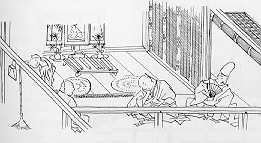 However, over time two scrolls were lost, and were replaced by repainted
versions as pictured in figure 3 from 1482. In comparing figures 1 and
2 with figure 3, one can note the 130 years of evolution of the element.
Since the function of the space is display, the earlier renditions of the
tokonoma show hanging scrolls in the background, as well as a low freestanding
table displaying various objects upon it .
However, over time two scrolls were lost, and were replaced by repainted
versions as pictured in figure 3 from 1482. In comparing figures 1 and
2 with figure 3, one can note the 130 years of evolution of the element.
Since the function of the space is display, the earlier renditions of the
tokonoma show hanging scrolls in the background, as well as a low freestanding
table displaying various objects upon it .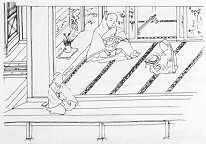 By the time of the 1482 picture the table has transformed into a raised
platform which defines the space for alcove. Although, the form has somewhat
been metamorphosed, the display funciton of the space remains constant.
The items that were previously displayed on the foretable have become standardized.
Typically an incense burner, a flower vase, and a candle holder are found
in the tokonoma alcove.
By the time of the 1482 picture the table has transformed into a raised
platform which defines the space for alcove. Although, the form has somewhat
been metamorphosed, the display funciton of the space remains constant.
The items that were previously displayed on the foretable have become standardized.
Typically an incense burner, a flower vase, and a candle holder are found
in the tokonoma alcove.
